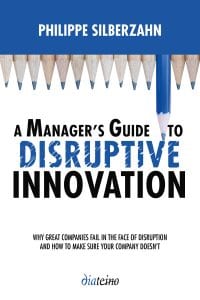And How to Make Sure Your Company Doesn’t
Today, no company can consider itself sheltered from disruption. If taxi drivers, who operate under a state-regulated monopoly, can feel threatened by a little application downloaded on a mobile telephone, then everyone can feel threatened. Who is next in line to be uberized?
For a company, disruption has two facets: as potential threat to its activity, but also as an opportunity to create new activities that are indispensable for its future growth. Here lies the tremendous potential of disruptive innovation. Companies imperatively need to understand disruptive mechanisms and build a capacity to transform them into advantages.
Twenty years ago, innovation specialist Clayton Christensen started with a simple question: how can a company maintain its leadership when its environment is dramatically shifting? To answer this question, he analyzed in depth the evolution of several industries in various domains and in which innovation is important: hard disks, department stores, and earth moving equipment. His research brought him to distinguish two kinds of innovation: sustaining innovation, which consists in improving existing products, and disruptive innovation, which consists in inventing new products. According to him, disruptive innovation is unique in the sense that it introduces new performance criteria and therefore implies a new value network and a new business model. Disruptive innovation targets different users and is not simply the improvement of an existing product or service.
What Christensen observed is intriguing: Market leaders often succeed in a sustaining situation where they can maintain and even reinforce their market position, but when there is a disruptive situation and a new player enters the market, they lose their position as leader. Sustaining innovation favors incumbent players whereas disruptive innovation favors new entrants.
How can that be explained? In fact, when facing a disruptive innovation, incumbent players are confronted with the following dilemma: if they embrace the disruption, they compromise their existent business without a guarantee that they will succeed in the new business. But if they reject the disruptive opportunity and in the short term protect their existent business, they compromise their future by missing on the opportunity. Faced with this dilemma, incumbent companies end up delaying key decisions regarding how they will embrace this disruption, and run the risk of their ultimate demise.
Christensen’s work is noteworthy because for the first time, one can understand why a company faced with disruptive forces fails. This failure does not emanate from a lack of competence, a lack of creativity among its collaborators, or an ignorance of the market; but really results from rational reasoning. One always prefers to invest one’s resources in an existent and real market rather than a future and uncertain market. And it is precisely this reasoning that produces unintended negative consequences and leads to disaster.
The dilemma explains why Kodak, despite inventing the digital camera, ends up disrupted by the digital revolution, why Blockbuster dismissed video on demand, why large hotel chains missed AirBnB, etc. More importantly, it offers a guide for any current leader to avoid this fate: Key to success in disruptive time is the ability to set up semi-autonomous business units able to pursue disruptive opportunities by creating their own business model without being overwhelmed by the legacy activity. This approach is at the root of successes like Nespresso or Renault’s Dacia low cost car division.
While no magic bullet, understanding the mechanism of the dilemma within your organization can pave the way to a successful strategy of not just resisting a disruption, but of taking advantage of it to reclaim leadership from new entrants.

I am a professor of entrepreneurship, strategy and innovation at emlyon business school and an associate researcher at the Ecole Polytechnic, where I received my PhD. My work focuses on the way in which organisations manage complex and radically uncertain situations both from an entrepreneurial and a managerial angle. I regularly speak on these issues for companies at conferences, seminars or as a consultant. My work is backed up by over twenty years of experience in the industry as an entrepreneur and company director.
I created the first ever MOOC (an introduction to entrepreneurship) in France, focused on effectuation. I am also the creator of the MOOC “IDEA, an introduction to design thinking”. Passionate about entrepreneurship, I am a member of the editorial committee of the journal “Revue Entreprendre et Innover“.
More information on Philippe Silberzahn:
• His CV online
• His blog
• His Academia Page
Further readings…

Silberzahn, P. (2017). A Manager’s Guide to Disruptive Innovation: Why Great Companies Fail in the Face of Disruption and How to Make Sure Your Company Doesn’t. Diateino, 216 p. ISBN: 978-2-35456-290-8.
Read abstract online


Recent Comments